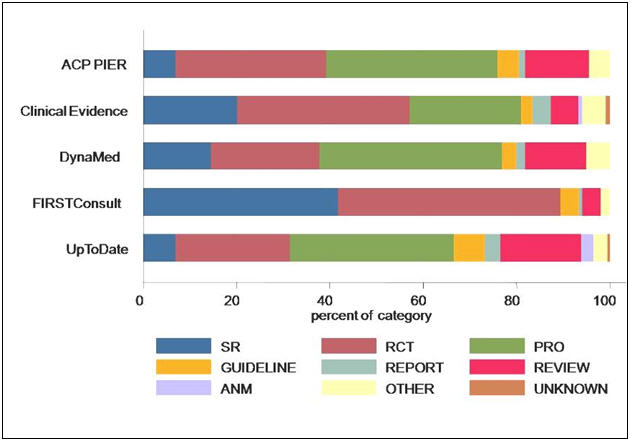At this year’s annual Medical Library Association conference, we reported on the results of our study which examined the type of evidence used to support content in some commonly used Point of Care (POC) products. The five POC products included in the study were UpToDate, Clinical Evidence, ACP PIER, DynaMed, and FIRSTConsult. The references from four topical monographs—hypertension, hyperlipidemia, carbon monoxide poisoning, and asthma—were analyzed in each POC product. The objective was to determine the level of evidence1 of each of the references; for example, a systematic review publication has a higher level of evidence than a practice guideline, which in turn is higher than a case report.
The results indicated FIRSTConsult used the largest proportion of publication types deemed to be higher levels of evidence to support its topical monographs. Clinical Evidence followed, with ACP PIER and DynaMed next, yielding similar total combined results, and finally UpToDate. Figure 1 demonstrates combined topical references for each product organized by publication type.
Figure 1:

An unexpected finding in this study was the limited overlap between references across products. The 4 subject monographs in all POC products yielded 2,330 references. Only 2 references were found in all 5 products. Only 4 references out of 2,330 were found in 4 products, 25 references in 3 products, and 161 references in two products. A total of 1,906 were found in only 1 of the POC products.
Figure 2 shows the breakdown of citations for each product combining all five topics into groupings by date. For most of the POC products, the majority of citations were from the pre–2001 time period and the fewest number of citations were from 2007–2009. As seen in Figure 2, some of the POC products had a much larger percentage of older literature as compared to other products.
Figure 2:

Readers should interpret our findings with some limitations in mind: relatively few topics were analyzed, and the type of research published is likely to vary depending on the topic. Also, despite efforts to categorize the citations by publication types as objectively as possible, some designations had to be subjective.
~ Andrea Ketchum and Ahlam Saleh
___________________________________
1 Guyatt G., Haynes B., Jaeschke R., et al., “The Philosophy of Evidence-Based Medicine.” In: Users’ Guides to the Medical Literature: A Manual for Evidence-Based Clinical Practice, ed. G. Guyett and D. Rennie, 9-16. New York: McGraw-Hill Medical, 2008.